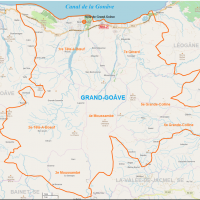Grand-Goave

Grand Goâve is a commune in the Léogâne Arrondissement, Ouest, Haiti
The Rivière de Grand Goâve passes to the east of the town. It is bridged by National Route No. 2 to the south and forded by Rue Tonnere to the east.
The city of Grand-Goâve has existed since at least the 16th century. Founded since the pre-Columbian period with the establishment of the first French on the western part of the island in 1627, it became the first city founded by the French adventurers. The city is recognized as the cradle of democracy following the revision of the 1816 constitution establishing Haitian Bicameralism, and recognized the freedom of the press under the aegis of Legislator J.B Sabourin and Chery Artais Pompé. First colonized by the Spanish and then the French, Goâve was split into two cities, Grand-Goâve and Petit-Goâve.
Grand-Goâve, one of the eighteen communes of the West Department, is a coastal city 64km southwest of Port-au-Prince. It’s location is known as “The Heart of the Southwest”. It has seven communal sections. The relief of the city is the plain and that of the communal sections is the mountains. Its climate varies according to the place where one is. Its inhabitants bear the name of Grand-Gôaviens. In 1998, the population of the municipality of Grand-Gôave was estimated at 65,951 inhabitants, the majority, or 95%, of this population lived in rural areas. By 2015, the population of this town had doubled. For an area of 1 Sq. Mi. (1.5 km2), the density of its Downtown was equal to 42,482 inhabitants per sq mi. (27,766 inhabitants / km2).
The Grand-Goâve River is the main river that has its mouth in Grand-Goâve. The river Lavange flowing east of the city, saw its only bridge destroyed. During cyclones and heavy rains, rivers overflowed and their tumultuous waters washed away houses and structures. Deforestation and non-drainage of rivers aggravate this situation. During the 2010 earthquake in Haiti, one of the Grand Goâve bridges, the one located on the Lavange River, was destroyed in the locality of Carrefour Fauché. Its reconstruction in 2011 was controversial because of the construction methods and it was nicknamed “bridge gongon” that is to say, bridge “can” which becomes dust. During a serious flood of the Grand-GoâveRiver and its many tributaries, the new bridge, said gongon was washed away. Another project has since been relaunched as this bridge is strategic for the supply, trade and movement of people to the entire Tiburon peninsula.
Since the 2010 earthquake in Haiti, a dam upstream of the Grand Goave River threatens to break down as a result of its weakening.
Education: The Ministry of National Education of Youth and Sports is not represented in the municipality of Grand-Gôave. Two kindergarten, several primary schools, five secondary schools and one vocational school were counted.
Health: The Ministry of Public Health and Population is not represented in the municipality of Grand-Gôave. A hospital (HGG) and three clinics were inventoried. Medical staff consists of nine physicians, a dentist, two nurses and five assistants.
Utilities: The municipality of Grand-Goave has a river, 43 springs, six traditional wells and public fountains equipped with eight taps and a dozen pumps. The City of Grand-Goave and part of the 1st and 7th communal sections are electrified by means of an electric motor. The feeding frequency is 84 hours per week.
Security: With regard to the Administrative and Judicial Infrastructures, the commune has a police station, a court of Peace and a registry office.
Religion: Nearly 100 Churches (Chapels and Temples included) have been inventoried in the commune of Grand-Gôave. The Pentecostal churches (46) turn out to be more numerous.
Organizations: The commune of Grand-Gôave has two Popular Organizations, two NGOs and one International Organization. 2 senior clubs (ASGG / Inter GG), several junior clubs like AGEFOOT, UNIONFOOT and ASPP.
Communication: A telephone office exists with a limited number of employees. The town has a postal office, the distribution of mail for the city is done by bicycle or on foot. She has radio stations located in the city. There is a high-performance communication network with around 7 radios and two TV channels such as SAKA radio, TV Radio Caciquat (TRAC FM), Radio Aguava FM, radio democracy, Creation FM, and Zanset FM. It has no newspaper / magazine.
Leisure: As for Leisure, the Municipality of Grand-Gôave has no Library, museum, theater, nor cinema. Football (soccer) is the sport practiced in the municipality. There is a park (Parc Ferrus) for the practice of soccer, it is in fair condition. In addition, three night clubs, 29 gaguères, three public places, beaches and a notorious vodun temple have been listed in the town.
Environment: When the earthquake of 2010 slammed into Haiti, Grand-Goâve suffered demolishment of its infrastructure. Every city building collapsed, schools crumbled, and City Hall and the police station were turned to rubble. The shaking produced a landslide that became a dam. When the rains came, the dam waters overflowed its banks and flooded Grand-Goâve. The U.S. and Catholic Relief Services provided disaster aid and participated in reconstruction efforts.

